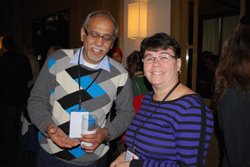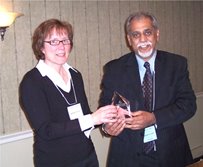Pat Letendre interviews our TM colleagues - past & present:
It's my pleasure, indeed an honour, to write a series of blogs for CSTM to celebrate the careers of transfusion professionals who came before and made a difference. Some names you may recognize, some you may not. But rest assured they all made a difference and we are the better for it.
Each blog begins with a brief background on the person's career, followed by musings on their career and my comments throughout. Although all participants enjoyed their careers and love the transfusion profession, they speak honestly about both the ups and downs. Perhaps their reflections will resonate with your experiences.
I will remember you: Ahmed Coovadia
This blog features Ahmed Coovadia, a medical laboratory technologist I first met during his tenure as CSTM VP, President, and Past President (2002-2008), a time when I was the CSTM webmaster. I never got to know Ahmed well but was impressed with his professionalism, indefatigable, balanced approach to issues, and graciousness - a gentleman, through and through. One of my favourite memories was at a CSTM Board meeting in 2007 where, during a break, Ahmed, as a proud Dad, was keen to show photos of his daughter's recent wedding, which I loaded on my laptop:
BACKGROUND
Before you can appreciate how Ahmed made a difference and understand his musings, you should know a few of his experiences. I encourage you to consider your career compared to his and how you may muse on transfusion medicine.
In brief, Ahmed did not start out to be medical laboratory technologist/scientist but we are very lucky he became one and also chose transfusion as his specialty. In Ahmed's own words:
"On completion of my undergraduate degree at Waterloo, I moved to Toronto to pursue a career in the medical field. I attended TIMT to broaden my scope with no firm decision on my final destination. The deciding factor leading to my tenure in the blood bank was through the mentorship of Peter Pinkerton and Marianne Sarnecki at Sunnybrook. Their encouragement in supporting me was instrumental in my professional growth."
Like others featured in CSTM's 'I will remember you' series, Ahmed has worked on both the hospital transfusion service side of blood transfusion and what I affectionately call the 'dark side' (the national blood supplier). For a few of Ahmed's many contributions to Canada's transfusion community and beyond, see a short resume.
AHMED'S MUSINGS
How did you make a difference and contribute?
To a large extend many of the contributions in my journey (anyone's journey) are related to two areas, the people / professionals and the organization's structure. I was very fortunate to have had the opportunity in the mid-1970s to not only undertake my internship, but also embark on my career in Transfusion Medicine at Sunnybrook Hospital in Toronto.
Initially, I began my tenure in the Division of Haematology (Transfusion Medicine, Haematology and Coagulation). In 1975, the first trauma unit in Canada was opened at Sunnybrook, which provided the foundation for the Transfusion Service to flourish under the astute leadership of Peter Pinkerton. The opportunities provided to the staff by Peter led to what I believe at the time was instrumental in our growth, primarily establishing very close collaboration with the clinical and nursing staff in the management of the critically ill patients.
We were considered a pivotal member of the patient care team and provided timely and appropriate service through acquiring a sound laboratory information system in addition to continuously reviewing and updating our serological procedures, such as the abbreviated crossmatch by the early 1980s.
Another highlight for our team was to receive AABB accreditation by the early 1990s (second institution to acquire this in Canada at the time). Through the initiatives that were prevalent in the blood bank in encouraging staff education and growth, we were fortunate to be able to attend the annual AABB conferences. The feedback from all to management led us to pursue the journey towards attaining accreditation.
Initially, we reviewed the requirements and undertook an internal assessment of our department. Next, it was imperative to obtain “buy in” not only, from the hospital staff but our staff who would be the key contributors in the success. Internally, we embarked on a comprehensive educational initiative on the quality plan and all of its essentials based on the AABB and ISO standards. The next phase was to roll it out to other departments within the institution.
Site visits to accredited institutions was initiated to learn the pros and cons. Attendance at the annual AABB workshops related to accreditation and quality management was pursued. No additional staff were allocated to this project as we strongly felt the initial and continued success can only be maintained with total participation of our staff. Hence a shared process of projects was spread among the staff, which led to further team building amongst all. The process took us approximately 9 months to completion once all the formal applications and requirements were met with AABB.
Under the tight restraints of fiscal challenges, and at the same time an exponential increase in workload, we were able to meet the needs of our patients through the evolution from the manual mode to automation.
With the creation of a dedicated transfusion service from the existing haematology, coagulation and blood bank service, challenges were prevalent in the areas of resources and continued increase in workload and demands placed on the staff in the blood bank primarily in meeting the needs of the trauma service.
With the implementation of the blood bank LIS and the introduction of technical changes (tube testing to column agglutination technology) we were able to a large extend to meet the immediate challenges. However, laboratory services ventured into the “private domain”, which created opportunities for the blood bank. Due to our expertise we were able to incorporate all blood bank activities from the private sector arm* into our domain. We acquired additional staff and a semi-automated instrument (Tecan Megaflex) to meet this challenge.
* The senior Management at Sunnybrook and Dynacare undertook this venture I believe with the intent on “efficiencies” among others. The blood bank at Sunnybrook due to its expertise in transfusion medicine and testing was tasked with testing all prenatal samples and, infrequently, ABO and Rh status, for all specimens collected in Ontario by Dynacare. Testing in the other disciplines were allocated after extensive consultation.
The workload increased by testing between 250 to 300 prenatal specimens daily with a 12 hour turn around time. After 5 years we separated from the private service to our original status. As change was a norm within our department, we embarked on many fronts to provide support for the growth of services within the institution:
- Cardiovascular Services;
- In-house autologous blood collection centre;
- Autologous stem cell collection, processing and storage;
- Establishing a Tissue and Skin Bank.
We were fortunate to be able to add additional staff but these challenges could only be met with the transition to “total automation” with the introduction of the Ortho Provue using the same technology of column agglutination.
What was the most fun?
The greatest pleasure in my career was to be able to make a difference in the lives of colleagues. The development of a strong “family” within the TM department and sharing of responsibilities were instrumental in providing opportunities to all staff members to experience personal growth.
Without management’s vision and commitment of staff participation on our mission in meeting the needs of our patients, I believe meeting the challenges would not have been possible. They were and are the key elements in our efforts to move forward. The experience gained technically and in managing projects provided the opportunities to many of our staff members to pursue management opportunities, not only in transfusion medicine but other related fields such as information technology and laboratory management outside of Sunnybrook.


PAT'S MUSINGS
As you can see, Ahmed became a transfusion professional in the mid-1970s, a time of great change in pretransfusion testing. He also was fortunate to have joined Sunnybrook Hospital, one of Canada's most progressive transfusion services and the creator of the
Bloody Easy continuing education / professional development programs.
Ahmed has a keen sense of humour. As an example, when I apologized for irritating him with my blog requests for more details, his droll reply was, 'It is very difficult to irritate me, but thanks for trying'.
Stay tuned for a second blog in which Ahmed muses on colleagues who made a difference in his career, his time on the CSTM Board of Directors, challenges facing the profession, contributions of Canadian Blood Services to our blood system, and his visits to transfusion services outside Canada.
Comments are most welcome. Please add to the record of what it was (or is) like to work as a transfusion professional in Canada.